Utility and Aesthetics of Caddies with Handles


Intro
Caddies with handles are much more than utilitarian objects cluttering countertops; they represent a growing trend within home design that merges practicality with style. As homeowners and designers increasingly seek to balance functionality and aesthetics, these versatile carriers find themselves at the heart of contemporary decoration schemes. With their ability to transform both the organization of space and the statement it makes, caddies deserve a closer look. This article will delve into their current role in home furnishings, highlighting key trends, design tips, and innovative materials that elevate them from mere storage solutions to focal points of personal expression in today's interior environments.
Trending Furniture Styles
Overview of Current Trends
In recent years, the design world has seen a shift toward minimalism and multifunctionality. Caddies with handles are a prime example of this shift, fitting seamlessly into various trending styles. The Nordic approach, emphasizing natural materials and simple shapes, finds its way into caddie design, resulting in sleek, functional storage options that don’t overwhelm the senses. Furthermore, the eclectic bohemian trend encourages the use of colorful patterns and unexpected materials, making caddies not just useful but also visually striking.
Caddies often serve as a bridge between styles, complementing both rustic and modern decor. Their versatility allows them to stand out or blend comfortably into a room, depending on the design choices made. This adaptability has caused a noticeable uptick in interest among homeowners and designers alike.
Key Elements of Popular Styles
When examining caddies within various design aesthetics, a few standout elements emerge:
- Material Choices: Natural wood, wire, and metal finishes dominate the scene. Bamboo caddies offer warmth and sustainability, whereas galvanized metal brings an industrial edge.
- Colors and Textures: Neutral tones dominate the minimalist designs, while pops of bright colors or rich textures appeal to bohemian themes. Patterned fabric handles add an unexpected twist to an otherwise straightforward design.
- Functionality vs. Style: Caddies that cleverly combine function with aesthetics, like those with dual compartments or adjustable handles, are becoming favorites among interior decorators. They cater to the need for organization while remaining stylish enough to display.
"A well-designed caddie transcends its primary purpose, acting as a conversation starter and a reflection of the homeowner's personality."
Practical Design Tips
Maximizing Space Efficiency
To fully utilize caddies within a space, consider their placement. Using them on dining tables for condiments or in home offices for supplies can create a sense of organized chaos that many modern design philosophies embrace. Simple tweaks can maximize their impact:
- Place a small caddie on a nightstand for easy access to nighttime essentials.
- Use larger caddies in the living area for remote controls or magazines, keeping things tidy and accessible.
Material and Color Combinations
Choosing caddies that echo the surrounding decor can enhance the overall aesthetic of a space. When selecting colors and materials, think about the ambiance of the room. Here are some practical combinations:
- A rustic wooden caddie with a distressed finish pairs beautifully with farmhouse-style decor.
- For modern spaces, polished metal caddies complement sleek furniture beautifully.
- Soft pastel colors on light textiles work well in children’s rooms, adding both function and whimsy.
By approaching caddies thoughtfully, homeowners can integrate them not just as functional items, but also as key players in their design narrative.
Links for further reading:
- Wikipedia on Home Design
- Britannica on Furniture Styles
- Reddit on Design Ideas
- Home Improvement Resources
In sum, caddies with handles embody a blend of utility and artistic expression that resonates strongly within the current design landscape.
Preface to Caddies with Handles
Caddies with handles are more than mere storage solutions; they embody a unique blend of practicality and style that can enhance any space. In recent years, the trend has shifted towards integrating functional items into home decor, making the study of these versatile carriers particularly relevant. Homeowners and interior designers alike recognize that caddies can serve a myriad of purposes, from organizing everyday items to adding a decorative touch.
Understanding the Concept
At their core, caddies are designed for mobility and convenience. They come in various sizes, materials, and designs, catering to a vast array of preferences and needs. Whether for holding kitchen utensils, art supplies, or bathroom essentials, the primary function remains constant: to facilitate easy access to items while minimizing clutter. Handles enhance this function, allowing users to transport items from one place to another effortlessly.
The appeal doesn’t stop at functionality. Caddies with handles are also a platform for personal expression. They can reflect one’s style, from rustic wooden designs that evoke a cozy atmosphere to sleek metal options that fit modern aesthetics. Incorporating such pieces into your home can transform ordinary organization into an opportunity for style.
Historical Significance
Caddies have a rich history that stretches back centuries, deeply rooted in the evolution of home design. Traditionally, they served pragmatic purposes, such as aiding in serving breakfast in bed or organizing tools. This concept of functionality didn’t change, but the styles and materials evolved.
In the Victorian era, ornate caddies became status symbols, showcasing wealth and taste. Fast forward to the mid-20th century, when caddies adapted to the minimalist movement, prioritizing simple lines and function over form. Today, caddies meld the old with the new, honoring traditions while embracing contemporary trends.
"Caddies with handles stand at the crossroad of utility and charm, speaking volumes of the spaces they inhabit."
From their historical role in facilitating organization to their modern-day usage as decorative accessories, caddies have carved out a significant niche in the realm of interior design.
Functional Aspects of Caddies
When it comes to caddies with handles, their functional aspects play a pivotal role in making them not just stylish decorative pieces but also essential tools for home organization and efficiency. This section dives into the significance of these features, examining how they enhance our living spaces in various ways.
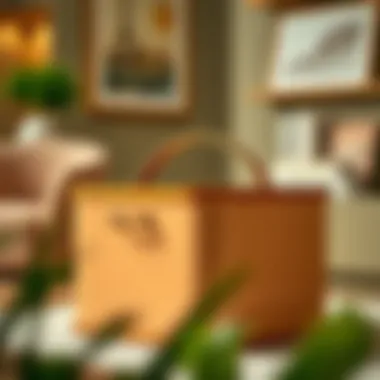
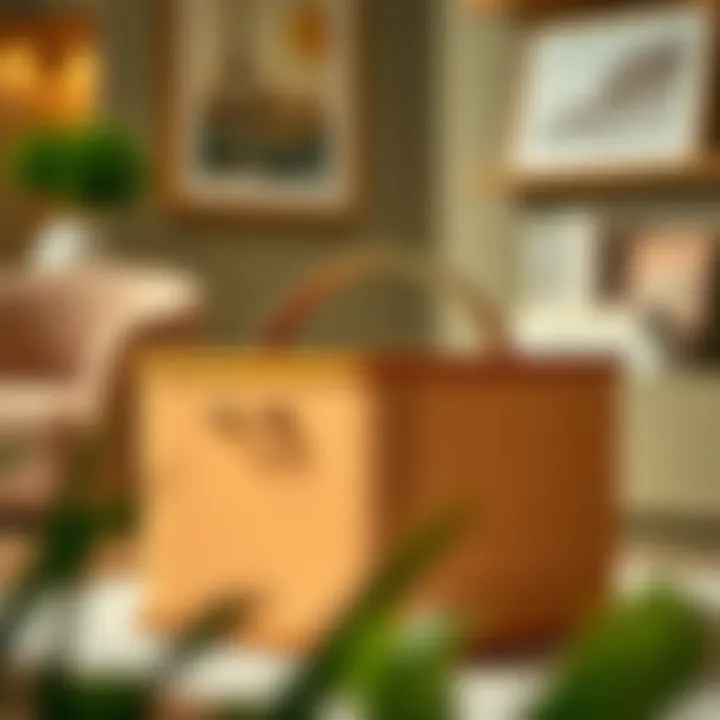
Organizational Benefits
Caddies are particularly noteworthy for their organizational benefits. In today's fast-paced world, keeping spaces tidy can feel like roundin' up cats. A well-designed caddy helps tackle the clutter that seems to multiply like rabbits.
- Segmentation of Items: Caddies provide the opportunity to categorize items. No more rummaging through drawers to find that one elusive spatula or that special pair of scissors. Picture a caddy equipped to store all your baking essentials - flour, measuring cups, and rolling pins neatly tucked away in compartments, easy to grab and use.
- Visual Appeal: When items are well-organized, they not only become easier to access but also contribute to the overall aesthetics of a space. A colorful caddy with distinct sections can serve as a focal point rather than an eyesore.%
"A place for everything and everything in its place" – this wisdom rings true in home organization, and caddies excel in fulfilling this mantra.
Versatility in Use
Another remarkable aspect of caddies is their versatility. These handy organizers don't have to stick to just one role or room; they could easily moonlight in various functions.
- Diverse Applications: From the kitchen to the home office, the potential uses for caddies are nearly endless. Think of a simple kitchen caddy doubling up as a craft organizer during your child's art project - brushes and paints all contained in one portable box.
- Adaptable Design: Many modern caddies come in various styles and materials, allowing them to meld seamlessly into different environments. A chic metal caddy could grace a bathroom countertop holding toiletries, while a cozy woven version might find its place among books in a living room.
Mobility Improvements
With mobility being a definitive characteristic of caddies, it’s crucial to note how this ease of transport significantly enhances functionality. Mobility isn’t just about the ability to move - it's about increasing efficiency in daily tasks.
- Easy Transportation: Caddies with handles allow for effortless transport of items from room to room. Need to serve snacks during movie night? Just grab the caddy filled with treats and drinks, and you’re all set for an evening of fun without any mess.
- Reducing Physical Strain: By providing a means to carry multiple items in one go, caddies can minimize the number of trips one needs to take. This not only saves time but can also be beneficial for individuals with mobility challenges, making their daily tasks simpler and more accessible.
In summary, the functional aspects of caddies are what set them apart as invaluable assets in home design. Their ability to organize, adapt, and facilitate movement contributes to a more efficient and aesthetically pleasing living environment.
Materials Used in Caddy Design
The selection of materials used in caddy design plays a pivotal role in their functionality, aesthetics, and overall impact on home decor. The right material can transform a simple caddy into a statement piece, elevating its usefulness while harmonizing with the surrounding environment. From durability to aesthetics, each material has its own set of benefits and considerations. This section delves into the distinct types of materials used for crafting caddies—wood, metal, wire, fabric, and eco-friendly options—providing insights into their individual characteristics.
Wooden Caddies
Wooden caddies evoke a sense of warmth and tradition. Often crafted from hardwoods like oak, walnut, or mahogany, wooden caddies make for a sturdy choice. Their natural grain patterns and rich tones can also add an organic touch to any room. The genuine nature of wood ensures that each caddy is unique, with variations in color and texture.
Benefits of wooden caddies include:
- Durability: High-quality wood offers longevity, making these caddies a long-term investment.
- Customization: Wood can be easily stained or painted, allowing homeowners to tailor it to their aesthetic preferences.
- Sustainability: When sourced responsibly, wooden caddies can be eco-friendly as they are biodegradable and often made from renewable resources.
However, considerations must be taken into account, including susceptibility to moisture and potential warping if not properly cared for. When choosing a wooden caddy, examining the finish is crucial; a sealed finish can help mitigate these concerns, ensuring longevity and maintaining its visual appeal.
Metal and Wire Caddies
Metal and wire caddies bring a fresh, modern edge to home organization. Often crafted from materials such as stainless steel, wrought iron, or coated wire, these caddies excel in both strength and contemporary aesthetics. They are particularly useful in utilitarian settings like kitchens or workshops due to their robust nature.
Highlights of metal and wire caddies include:
- Lightweight: Compared to wood, metal options can be significantly lighter, which enhances mobility without compromising on stability.
- Sleek Design: Their minimalist forms and clean lines contribute to a streamlined look that works well in a variety of settings, from industrial to modern homes.
- Ease of Maintenance: Metal caddies are typically resistant to stains and easy to clean, making them practical for high-traffic areas.
On the downside, metal caddies might not provide the same warmth as wood. Additionally, if not properly coated or treated, they can be prone to rust. Choosing rust-resistant finishes can mitigate this risk, making them suitable for various climate conditions.
Fabric and Eco-Friendly Options
In recent years, the trend has shifted towards fabric and eco-friendly materials in caddy design. Fabric caddies, often made from durable polyester or cotton canvas, offer a softer touch and a variety of styling options, making them ideal for casual or eclectic spaces. Eco-friendly options, which may use recycled plastics or sustainably sourced materials, highlight an increasing awareness of environmental responsibility in home decor.
Considerations for fabric and eco-friendly caddies:
- Versatility: Fabric caddies can often be folded for easy storage and come in numerous designs or patterns, catering to individual tastes.
- Lightweight: They are generally light and easy to move around, suitable for a spontaneous use around the house.
- Sustainability: Eco-friendly caddies are often made with the planet in mind, appealing to environmentally conscious consumers.
However, fabric caddies may not have the same structural integrity as wood or metal, and patterns can sometimes limit their versatility in decor unless the colors are chosen thoughtfully. They may also require more frequent cleaning, especially in homes with pets or kids.
"Selecting the right material for your caddy is not just about style; it’s about creating a balance between functionality and the environmental footprint it leaves behind."
In summary, the material used in caddy design is essential in defining not only the functional capacity of the caddy but also its integration into personal decor. Homeowners can make informed choices based on their lifestyle, aesthetic preferences, and sustainability values.
Design Trends in Caddies
In the evolving landscape of home decor, caddies with handles have emerged not just as practical tools but also as statements of personal style. Design trends today emphasize the duality of function and aesthetic appeal. Caddies are increasingly designed to fit seamlessly into various interior themes, from minimalism to industrial chic, allowing homeowners, designers, and decorators to select options that align with their vision. This section will delve into three prominent design trends that are shaping the way caddies are perceived and utilized in contemporary homes.
Minimalist Aesthetic
The minimalist trend celebrates simplicity, where less is indeed more. Caddies designed in this style often boast clean lines, neutral palettes, and an absence of cluttered embellishments. These caddies serve a practical purpose while contributing to serene and uncluttered living spaces. The emphasis is on the essence of the item, bringing forth the beauty in simplicity.
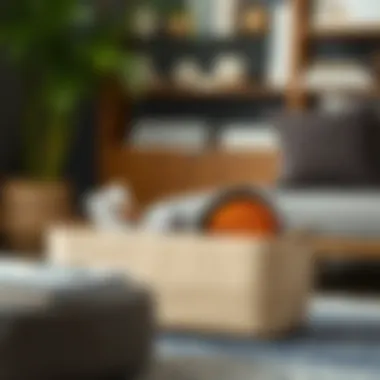
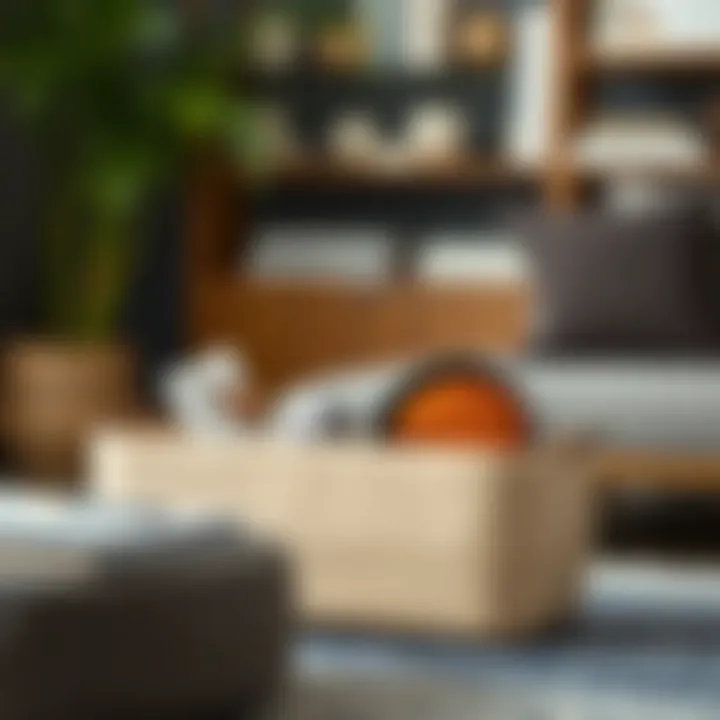
Benefits of Minimalism in Caddies:
- Visual Clarity: A tidy caddy emphasizes organization, making it effortless to locate essentials.
- Versatile Integration: Minimalist designs can blend effortlessly into various decors without overpowering other elements.
- Functional Serving: Minimalist caddies, such as those from brands like Muji or IKEA, often feature multi-utilitarian designs that serve different purposes without complication.
Characteristics to Consider:
- Material Choice: Select light woods or metals that reflect simplicity.
- Size and Shape: Opt for geometric shapes that complement linear spaces.
- Finishing Touches: Choose matte or soft sheen finishes to maintain a clean look.
Bohemian Inspirations
On the other side of the design spectrum lies the bohemian aesthetic. Caddies that draw inspiration from bohemian design tend to be vibrant, eclectic, and rich in texture. They incorporate patterns, colors, and mixed materials, allowing homeowners to express individuality and creativity through their decor.
Benefits of Bohemian Caddies:
- Artistic Expression: These caddies allow users to showcase personal tastes and life experiences encapsulated in vibrant hues and diverse patterns.
- Conversation Starters: Their distinctive look can easily draw attention, sparking conversations amongst guests.
- Cultural Fusion: Bohemian caddies often feature woven fibers or ethnic prints, facilitating a rich tapestry of cross-cultural appreciation.
Features to Explore:
- Textiles and Patterns: Incorporate colorful fabrics or woven materials.
- Layering: Use various shapes and heights in caddy arrangements for a collected look.
- Decorative Elements: Including beads or fringe can enhance visual interest without overwhelming.
Industrial Style Adaptations
The industrial style is marked by raw materials and unfinished textures, often reminiscent of a warehouse or factory aesthetic. Caddies designed with this style reflect a rugged charm that embraces imperfection. The appeal lies in their robust construction and the authenticity these pieces convey within a modern home setting.
Benefits of Industrial Caddies:
- Durability: Made from metal and reclaimed wood, these caddies are built to last and can withstand heavy use.
- Character: Their distressed finishes add a layer of authenticity and style that complements loft-style living.
- Functional Design: Often featuring spacious compartments, they facilitate organization while enhancing the overall aesthetic.
Options for Industrial Design:
- Material Blend: Combine steel with reclaimed wood for contrasting textures.
- Metallic Finishes: Consider aged brass or brushed nickel for accent touches.
- Structural Elements: Exposed bolts or rivets can add to the rugged appeal.
Incorporating Caddies into Home Decor
In the realm of home decor, caddies with handles deserve more than a passing glance. These versatile organizers are not merely functional; they bring a charm and personality to any space they occupy. Understanding how to incorporate caddies into home decor can unlock new potential in your living environment, infusing it with both order and style. Whether you're aiming for sleek organization or a pop of character, the possibilities are plentiful.
Living Room Arrangements
The living room often serves as the heart of the home—a gathering space for family and friends. Integrating caddies into this area can significantly enhance both aesthetics and functionality. For instance, consider a chic wooden caddy perched on a coffee table, filled with coasters, remote controls, or even a selection of books. This not only centralizes often-misplaced items, but it also contributes to a curated, thoughtful look.
When arranging a living room, think about positioning caddies in spots that naturally encourage use. Place a stylish metal caddy near a seating area, filled with snacks or refreshments, to invite social interaction. A vibrant fabric caddy can also serve well in children's play areas, holding toys while cleverly adding a splash of color.
Kitchen Organization
In the kitchen, the importance of organization can't be overstated. Caddies function remarkably well here, streamlining everything from spices to utensils. A wooden caddy housing various oils and vinegars near the countertop not only offers convenience but also serves as a decorative element enhancing the culinary workspace.
The caddy's mobility is its secret weapon. Imagine a metal caddy filled with baking necessities, easily transported from cupboard to counter, ensuring that you have everything at hand when the baking bug bites. Moreover, integrating a fabric caddy beneath the sink can cleverly conceal cleaning supplies, merging practicality with understated design.
Bathroom Storage Solutions
Bathrooms are often tight on space, making the clever use of caddies an essential strategy for maintaining order. A beautifully crafted wooden caddy can hold toiletries, towels, or even candles, creating an inviting atmosphere. Visual appeal meets function, as the handles make it easy to relocate items as needed.
A fabric caddy can also add a soft texture to the otherwise utilitarian bathroom space. Positioning it on a shelf or under the sink allows for a neat collection of hair care products and bath essentials, making daily routines more efficient. In essence, caddies can transform chaotic spaces into serene, well-organized retreats.
Incorporating caddies into your home decor is not just about organization; it’s about expressing style and enhancing the functionality of your living space.
Innovative Features in Modern Caddies
As home design evolves, so do the functionalities of everyday items. Caddies with handles are more than just a practical solution for organization; they have matured into modern marvels that incorporate innovation into their very fabric. It’s not just about putting your belongings together; it’s about enhancing the user experience while making a statement. Delving into the innovative features of these caddies gives homeowners, designers, and decorators insight into how they can enhance both utility and aesthetic appeal in their spaces.
Built-in Charging Stations
Modern living demands convenience, and built-in charging stations in caddies are a game changer. Imagine having a setup that not only organizes your essentials but also powers your gadgets. With the proliferation of smartphones and tablets, many households find themselves tucked away with stray charging cables. Caddies equipped with charging options allow users to eliminate that clutter while offering a seamless charging experience.
These charging stations can be designed to suit various devices. Often, you’ll find them outfitted with multiple USB ports, ensuring that all family members can connect their devices simultaneously. Not to mention, this feature is a boon for designers, providing an opportunity to construct aesthetically pleasing caddies—where functionality and style come together in a tidy package. This integrated approach turns an ordinary caddy into a focal point in any room.
"Innovative design drives utility; with built-in charging stations, caddies stand at the crossroads of convenience and style."
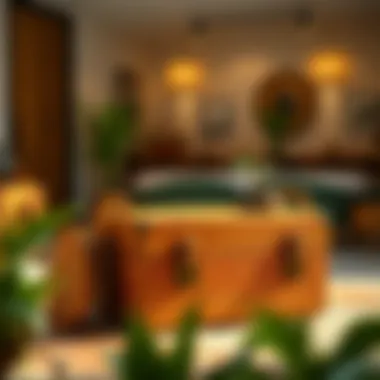

Collapsible and Expandable Designs
Flexibility is key in modern homes, especially in small spaces. Collapsible and expandable caddies address this need by providing versatile storage solutions. This feature gives users the freedom to adjust sizes according to quantity of items or available space. Whether it is a spontaneous picnic or simply rearranging a room, the ability to collapse a caddy to fit your needs can make a striking difference.
Often made from lightweight materials, these caddies can be easily stored away when not in use. The expandable variants, on the other hand, can grow with your household. As you accumulate more belongings or entertaining requirements, these caddies adapt, making them the ideal addition for dynamic lifestyles.
- Benefits of Collapsible and Expandable Caddies:
- Space-saving solutions for limited areas.
- Easy mobilization for various purposes.
- Customizable based on your inventory needs.
Customizable Compartments
In a world where personalization reigns supreme, customizable compartments in caddies have gained traction. This feature allows users to create tailored spaces within their caddies for different items, enabling efficient organization and easy access. It's like having a small control center for your belongings, designed specifically to fit your unique requirements.
These compartments can often adjust in size and shape, thanks to movable dividers. Picture a caddy that holds your art supplies at the right hand while keeping your gardening tools organized on the left. The beauty of customizable compartments is how they cater to individual lifestyles— from study stations to hobby corners, these aspects turn caddies into personalized islands of order amidst the chaos of daily life.
Combining innovation with utility, the features present in modern caddies represent a significant leap forward in how we organize and beautify our spaces. Emphasizing practicality without compromising aesthetics further establishes caddies as essential components in today's households.
Choosing the Right Caddy
Choosing the right caddy is not merely about picking one that looks good. It encompasses understanding your personal needs, the specific function it will serve, and how it will harmonize with your existing decor. A well-chosen caddy can bridge the gap between aesthetic appeal and functionality. As we dissect the essentials of selecting an ideal caddy, let’s delve deeper into three pivotal elements: space, personal style, and sustainability.
Assessing Your Space Needs
Before even stepping into a store or browsing online, it's essential to take stock of where the caddy will reside. Every nook and cranny of a home has its own unique dimensions and constraints. Measuring the space is fundamentally important. If a caddy is too bulky, it might overcrowd a small living area, while a too-small one might not hold the necessary items you require. Think about not only the physical space but also how frequently you’ll need to access the caddy.
- Space Type: Are you placing the caddy in a busy kitchen, a serene bathroom, or perhaps as part of your living room decor? Each context demands a different size and style.
- Accessibility: Arrange the items in a way that is thoughtful for your daily routine. If it’s in the kitchen, ensure that utensils are easily reachable while cooking.
Personal Style Considerations
The aesthetics of a caddy can significantly influence your home decor. Personal style should guide your choice—are you leaning towards rustic, modern, or eclectic? Dressing a caddy in a design language that syncs with your home will elevate both its functionality and decorative presence.
- Color Schemes: Consider hues that complement your existing palette. A dark-stained wood caddy can add a warm touch to a minimalistic white kitchen, while bright colored metal can enliven an otherwise muted workspace.
- Integration with Existing Decor: Perhaps you have bohemian decorative pieces; a caddy in a woven design may seamlessly fit in while holding magazines or plants.
Sustainability Factors
In recent years, the importance of sustainability has morphed into a purchasing motivator. Your choice of a caddy can reflect your environmental ethos. Opting for eco-friendly materials isn’t just a trend; it's a necessity for many conscientious homeowners today.
- Material Source: Look for caddies made from sustainably sourced materials like bamboo or recycled metals. These are not only sturdy but also reduce your carbon footprint.
- Long-term Use: Invest in quality over quantity. A well-made caddy can last for years, reducing the need for frequent replacements and consequently, waste.
In summary, selecting the right caddy is about more than just aesthetics; it’s a thoughtful process that incorporates space needs, personal style, and sustainability. In a world filled with choices, a carefully crafted caddy will not only serve practical purposes but can also be a conversation starter, reflecting the personality of your home.
Epilogue: The Future of Caddies
As we look ahead to the future of caddies with handles, it's clear that these multifunctional items are likely to evolve in exciting ways. With the increasing emphasis on personalization and adaptability in home decor, caddies are not just storage solutions anymore; they are becoming integral players in the design narrative of our living spaces. Their ability to combine functionality with visual appeal positions them uniquely in contemporary interiors.
Anticipated Trends
The landscape of caddy design is changing, influenced by shifts in consumer preferences and technological advancements. One significant trend to watch is the integration of smart technology. Imagine a caddy that not only holds your kitchen supplies but also reminds you of expiration dates or helps track inventory via a connected app.
Moreover, sustainability is becoming paramount. More manufacturers are leaning toward upcycled materials and eco-friendly processes. Products made from recycled plastics or sustainably sourced wood are not just appealing from an aesthetic standpoint; they also cater to the environmentally conscious consumer.
In addition, we could see diverse designs that cater to various tastes. As minimalism becomes a staple, we will continue to see sleek, open designs with clean lines. Contrast that with more bohemian, handcrafted variants showcasing intricate details and natural textures. Both styles can coexist, allowing people to choose what resonates with their personal style.
- Smart designs: merging tech with traditional caddies.
- Eco-friendly materials: a growing public demand.
- Variety in styles: catering to individual preferences.
Evolving User Preferences
Evolving user preferences are steering the future of caddies. People today value experiences over mere possessions—they want items that enrich their lives. Thus, caddies will increasingly need to strike a balance between utility and experience, offering not just a place to organize, but also enhancing daily activities.
For instance, in a bustling household, a well-placed caddy in the kitchen might serve not just to store utensils, but also facilitate a collaborative cooking experience, making meal preparation a more social occasion. This reflects a significant trend toward creating spaces that encourage interaction and community.
Additionally, aesthetics are taking the front seat. Caddies are no longer hidden away in cabinets; they are becoming statement pieces on countertops, showcasing beautiful designs that align with a homeowner's decor.
As preferences shift, designs must adapt:
- Functionality that encourages togetherness: promoting interaction and shared experiences.
- Aesthetic appeal: transforming caddies into decor elements rather than just storage solutions.
As we can see, the future of caddies is bright, filled with possibilities that marry practical needs with innovative flair. Homeowners, designers, and decorators alike should keep an eye on these trends, for they will shape how we view and use these essential items in the years to come.
"Caddies with handles are poised to become more than just functional tools; they will emerge as essential elements in expressive and innovative home environments."
For further reading on design trends and sustainable living, you might find Britannica and Wikipedia helpful resources.



